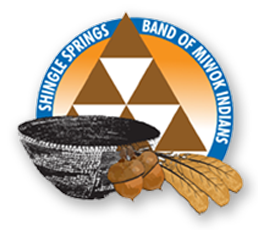A Brief History of the Tribe
The Shingle Springs Band of Miwok Indians is a federally recognized Tribe located in El Dorado County, California. The members of the Shingle Springs Band of Miwok Indians are descendants of the Miwok and Southern Maidu “Nisenan” Indians who thrived in California’s fertile central valley for thousands of years before contact with Europeans.
Gold Rush Brought Devastating and Sustained Genocide
Although early encounters between Indians and Spanish colonizers in the late 1700s resulted in some violence and spread of disease, it was not until the California gold rush of 1849 that the Miwok and Southern Maidu “Nisenan” Indians experienced devastating and sustained genocide. As a result of the gold rush, Indians in northern California lost the use and control of their aboriginal territories, which forced whole tribes to scatter.
The impact of the gold rush era is revealed in population statistics. In 1769, an estimated 310,000 native people lived within the borders of the modern-day California. By 1913, only 17,000 Indian people remained in the area.
Shingle Springs Rancheria Established
Despite these harrowing obstacles, Miwok and Southern Maidu “Nisenan” Indians survived the 19th century. In 1916, while conducting a census of Indian people, an agent of the Department of the Interior discovered Indians living along the Sacramento River. The federal government called these native peoples the “Sacramento-Verona Band of Homeless Indians” and set about acquiring land for them. That land is known as the Shingle Springs Rancheria, just off present-day U.S. Highway 50.
In 1970, the Tribe formally organized under their Articles of Association and set up home sites on the Rancheria. In 1976, the Tribe’s Articles of Association were approved by the Secretary of the Interior.
Under the Articles of Association, the ultimate authority of the Tribe rests with its general membership. An elected Tribal Council governs the Tribe and a Tribal Chairperson carries out the day-to-day operations. The Tribal Council is responsible for all government functions (legislative, judicial and executive) while the Chairperson has general authority when the Council is not in session.
Since the adoption of the Tribe’s Articles of Association in 1976, the Tribe has sought to honor and protect its territory and cultural heritage to benefit future generations.
Tribe’s Journey to Economic Self-Sufficiency
On the journey to economic self-sufficiency, the Tribe faced major obstacles. In particular, the 1965 realignment of U.S. Highway 50 landlocked the Rancheria. From 1965 until 2008, the only access to the Rancheria was by a narrow, winding, rural road. The severe restriction on access to the Rancheria proved a major impediment to the economic growth of the Tribe. In 2008, after years of struggle and litigation, the Tribe celebrated the opening of a newly constructed overpass which provides access to the Rancheria via Highway 50.
The Rancheria has changed significantly from its humble beginnings and today is a bustling, vibrant community. The Tribe is financially independent and has diverse enterprises and programs including, most notably, Red Hawk Casino, the Shingle Springs Health & Wellness Center and the Tribal TANF Program. Its Business Development Board is dedicated to developing other enterprises for the Tribe’s long-term sustainability.
Tribe’s Substantial Economic and Social Impact in El Dorado County
The Shingle Springs Band of Miwok Indians is deeply committed to sustaining and improving the quality of life in El Dorado County. This guiding principle is a responsibility and a privilege of the Tribe as it strives to make a meaningful difference in the lives of its members, employees and patrons as well as the citizens and guests of El Dorado County.
Timeline
Drawing on the resilience of their ancestors, the Tribe continues to evolve socially and culturally, contributing positively to the community.
- 28,000 B.C: Earliest discovered Indian remains
- 1542: California Indians encounter early European explorers
- 1769: An estimated 310,000 native people live in what is now California
- 1830s-40: Mexicans and Americans occupy traditional Indian lands
- 1849: Gold discovered at Sutter’s Mill results in the confiscation of Indian land by 49ers, and the introduction of diseases foreign to the native population, including smallpox
- 1913: The total California Indian population numbers only 17,000
- 1916: During a census, Indians are discovered living along the Sacramento River
- 1920: Deed obtained for the 160-acre Shingle Springs Rancheria for use and occupancy of the Sacramento-Verona Band of Homeless Indians
- 1950s: “Termination Era” policies force native people into urban areas
- 1970: In conjunction with the federal government, the Tribe sets up formal home sites for Tribal members on the Rancheria
- 1976: The Tribe’s Articles of Association approved by the Secretary of the Interior
- 1980: Fewer than 20% of California Indians live on reservations
- 1995: Tribe establishes what is now the Shingle Springs Health & Wellness Center to provide healthcare to underserved native and non-native families
- 2008: The Tribe opens its overpass in November providing access to the Rancheria. The Tribe opens Red Hawk Casino in December.
- 2009: The Tribe establishes a Tribal Court system
- 2010: The Tribe opens the Shingle Springs Tribal TANF Program to assist needy Indian families who reside in El Dorado, Placer and Sacramento Counties

